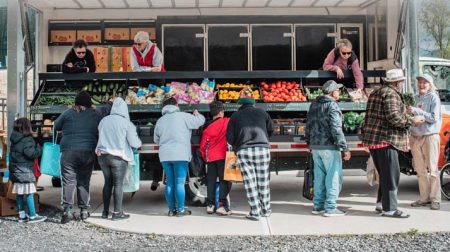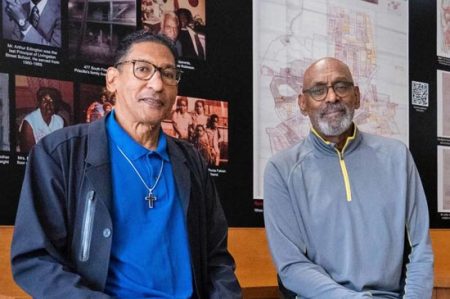Helping the Homeless in Asheville
by Cathy Holt
 |
| Photo by Cathryn Shaffer |
The plan calls for immediately providing chronically homeless people with a place to live and then following up with other needed services, rather than requiring them to start drug treatment or get a job in order to be eligible for housing.
The program is part of a federal initiative that the City and Buncombe County endorsed in a January 2005 joint resolution; Council will allocate its grant to the Affordable Housing Coalition of Asheville and Buncombe County, the plan\’s lead agency. With matching funds from the county, the coalition will hire and train a project coordinator to be the liaison for participating local agencies and service providers.
The city is using federal Community Development Block Grant funds from the Department of Housing and Urban Development. Additional funding will be sought to pay for actually housing the homeless.
The “chronically homeless” are a small group that
accounts for a substantial portion of what a community spends on its
homeless population for shelters, emergency-room care and law
enforcement. In Asheville, about 36 people cost a third (more than
$18,000 each) of the roughly $2 million the city and county together
spend for the homeless each year, according to Councilwoman Holly
Jones. Housing those three dozen people will create immediate savings
for the community.
Church of the Advocate
 |
| (L-R) Lonnie Burris, the Rev. Deacon Ann Fritschner, Michael Kubicek. Support for the homeless is among the many things offered at Church of the Advocate located in the undercroft of Trinity Episcopal Church in downtown Asheville. Photo by Cathryn Shaffer. |
Reverend Deacon Ann Fritschner is the chaplain of the Church of the
Advocate, an Episcopal congregation (housed in Trinity Episcopal
Church) whose mission is to help serve homeless persons in Asheville.
It holds a Thursday prayer and healing service at A Hope, giving
attendees “a respite from the chaos.” With funding from several
Episcopal churches, it offers a “clothes closet” and a parish nurse and
has helped one formerly homeless person enroll in AB Tech. An estimated
two-thirds of attendees are homeless; others are “on the edge,” living
on Disability or in Section 8 housing. Fritschner hopes to begin
offering help with managing finances and getting employment skills.
“Very few of the 500 or so homeless people in Asheville really want to
be homeless,” says Fritschner.
A formerly homeless man who attends the Church of the Advocate, Bob
White, believes that churches could take more leadership and act on
what they preach. “Look at the homeless and the poor as people,” he
suggests. “People need hope, they don\’t need to have doors shut in
their faces.” White is discouraged about how A Hope has changed, seeing
fewer services even while the staff has expanded. Although promised a
job there, he never got it. An African American man, he is also keenly
sensitive to the racism that he perceives from people even as they walk
out of churches. One change for the better that he perceives is that
the Asheville Police Department under Chief William Hogan treats
homeless people more compassionately than it used to.
The 75 members of the nonprofit Asheville Homeless
Network, founded in April 2004, include the homeless, the formerly
homeless, and their allies. AHN\’s goals are: (a) to get information to
the homeless population about what help is available and where; (b) to
inform them of their rights and the local laws that affect them; (c) to
engage organizations and churches to help individuals directly; (d) to
change the public\’s perception of the homeless; and (e) to educate city
and county officials about homeless people\’s needs. Its web site
(www.ashevillehomeless.org) offers a wealth of information.
Moss Bliss, the group\’s founder, is one of 60 beneficiaries of the
“Shelter Plus” program, which provides partial funding for permanent
housing and a utility allowance to homeless people diagnosed with
mental illness. According to Bliss, AHN would like to build or buy a
handcart that, once licensed by the city, would be used to sell
handicrafts made by local homeless people. AHN members will also sell
Kindness Campaign bumper stickers for a small profit. Following the
lead of Seattle and Indianapolis, AHN envisions a “tent city” (with
porta-potties and possibly showers) on surplus city property, to
provide low-cost shelter.
“One site could be on land next to Broadway, between downtown and
UNCA,” suggests Bliss. “People could pay a modest rent for their sites,
perhaps $5 per week.” AHN also advocates that local shelters meet the
needs of the homeless more effectively and humanely. The Salvation Army
charges a homeless person $10 per night for a bed, he says, and “all
but the ABCCM shelters close their doors at 4:00 p.m., making it
impossible for a person with a job to utilize them.”
Bliss concedes that some homeless have “fallen off the mental-health
wagon, but at least half of the homeless have jobs. They just don\’t
have good enough jobs to afford housing — to be able to live anywhere.”
Bliss believes that the city\’s 10-year plan to end homelessness is
really “a plan to save money, by dealing with the worst 10%,” rather
than to help the majority of homeless people. “The 600 documented
homeless does not include those who sleep in their cars or on their
friends\’ couches.”
Bliss advocates that church and civic groups to participate in AHN\’s
“Adopt A Homeless Person” program. For two months a group provides such
services as: a place to do laundry and to shower or bathe; emotional
support; help with “interview” clothes; rides to and from job
interviews and medical appointments; monthly bus passes; a phone number
for potential employers to call; help with housing; and training in
budgeting, conflict resolution, etc.
The group also needs donations of fabric, yarn, and sewing and knitting
supplies members can use to create handicrafts; camping equipment and
bicycles for a lending library; and storage space for donated items. In
2005 AHN donated 6 caps, 3 scarves, 1 heavy coat, 2 blankets, and a
winter business dress to A HOPE and to needy individuals.
Gifts of money can be made directly through the AHN web site or via
collection jars at downtown businesses (the Grove Arcade Corner Market,
Vincenzo\’s Restaurant, and The Sword & The Grail), and indirectly
by buying items online from one of the group\’s affiliated companies,
such as Target, Office Depot, or Cingular Wireless (all of which donate
a percentage of sales to the organization).
The Asheville Homeless Network holds meetings every Thursday at 2:00
p.m., upstairs in The Perch at the Grove Corner Market in downtown
Asheville. On the first and third Thursdays each month, there is a
business meeting; on the second and fourth Thursdays, a support group.
For more information, call 254-7449.
Room At The Inn
Room at the Inn is a floating program that brings some 25 area
churches into the mix of helping those in need of shelter. Aimed at
helping women who find themselves homeless — including those fleeing
abusive relationships — the program recruits church congregations to
make a limited, short-term commitment to providing shelter and meals.
For the past five years, the program has been helping homeless women
year-round.
Some churches house and feed the women three or four weeks per year.
The women are screened by Hospitality House/A Hope and then picked up
by a church van or volunteer drivers. Sharon Blythe is the church
coordinator for this program. Among the churches that regularly
participate are the Cathedral of All Souls, First Presbyterian, and the
Unitarian-Universalist Church of Asheville.







